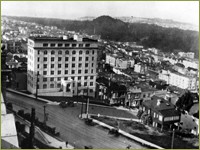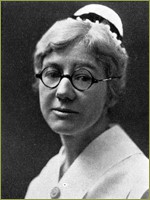1919–1939 The Formation of Schools and the Rise of Clinical Science Instruction
Developments in Nursing Education
On November 19, 1917, just a few months after the opening of the new UC Hospital, University President Wheeler announced a five-year nursing baccalaureate degree which included two years of university work at Berkeley, followed by three years of training in the UC Hospital. The ideal of a nursing baccalaureate was a welcome development, but its appearance at this time was a top-down decision made by a committee composed primarily of Berkeley faculty and Parnassus physicians. In late 1917 Hospital superintendent H.T. Summersgill protested the timing of the new program, in a letter revealing the realities of wartime depletion of medical personnel on the homefront. He feared an unmanageable increase in the student body, given the loss of many supervising nurses and teaching physicians due to wartime staffing, as well as the lack of proper accommodations for nursing students. Despite these objections, the Academic Senate approved the baccalaureate nursing program on March 1, 1918. By mid 1918 superintendent Summersgill left and was replaced by Dr. William E. Musgrave, who had been superintendent of Children’s Hospital, and was a well-known supporter of nursing education. At the same time, Louise Morrow, a pediatrician with training in social economics from Berkeley, took over as director of nursing for both the training school and hospital. Dr. Morrow held a concurrent position as Chair of the Medical School’s department of Social Service until 1921 and she helped link the training school intellectually and academically with the school of medicine. Another crucial nursing faculty appointment occurred in autumn of 1918 when Edith Bryan, a nurse from Pasadena Hospital, was named by the Regents as assistant professor to create the public health nursing program at Berkeley. She effectively developed the certificate program from a summer session into an impressive and popular eight-month academic year program. In the mid-1920s she took a leave and completed a Master’s and Ph.D. in psychology at Johns Hopkins. Not only was she the first nurse to be appointed to the university faculty, she was the first American nurse to earn a doctoral degree. Her influence and her competent direction of the public health certificate program became an important factor effectively linking the Parnassus based nurses’ training school with Berkeley’s departments of Hygiene and Social Economics.The immediate postwar years saw the permanent establishment of the five-year baccalaureate program, with students from Berkeley, Mills College and the College of the Pacific matriculating for their clinical nurses training at Parnassus. The public health certificate program was continuously enhanced and elaborated by Edith Bryan, who remained director of the program in the Department of Hygiene until 1933.
Although upgrades in curriculum served as evidence of the growth and maturation of the training school for nurses, the most visible enhancement came in the form of the long-awaited completion and occupancy of a seven-story nurses dormitory building across from the UC Hospital at 610 Parnassus.
As negotiations among two UC Presidents and medical faculty at Berkeley and Parnassus continued unsuccessfully and somewhat acrimoniously in the 1920s, a remarkably different story of cooperation between campuses evolved in the training school for nurses. The name of the school itself reflected this shift in focus. The “University of California Hospital Training School for nurses” officially became the “University of California Training School.” In 1922 Mary May Pickering, a graduate of the Massachusetts Hospital training program, was appointed Director of the Training School and Superintendent of Nursing. In a series of subtle policy shifts during the 1920s she successfully aligned the training school with the University in several ways involving curriculum, governance, and academic schedule. Admissions requirements for nursing students had required a high school diploma from the school’s beginnings, and under Pickering’s direction, requirements began to resemble University admission standards. In 1923 Miss Pickering persuaded the Academic Senate to review the training school curriculum, thus placing the school directly under the supervision of the University rather than solely the Medical School. Over time, the training school’s advisory board shifted in composition towards a greater ratio of Berkeley faculty to Medical School officials. In a final important change, the University’s term schedules and letter grading system were adapted to the training school years. An important symbolic incident occurred in 1923 when nurses were formally invited to participate in the UC graduation ceremony at Berkeley. While strategically steering the training school, Miss Pickering also maintained an active role in the nursing profession, serving as editor of the Pacific Coast Journal of Nursing. She also supported the Training School’s membership in the Association of Collegiate Schools of Nursing, representing UC at the founding of the Association in 1934.
Another important Berkeley landmark for nurses’ training in California occurred in 1925 with the creation of the Foundation in Nursing Education with funds accumulated from the Bureau of Registration of Nurses. In a remarkable show of cooperation, nurses secured legal advice, and introduced a legislative bill appropriating funds to the University of California to create a chair in Nursing Education in the Department of Hygiene at Berkeley. The governor signed the bill on May 23, 1925 and in 1926 an advisory committee worked on recruitment and curriculum. On January 1, 1927 the committee appointed Miss Pickering professor of nursing education at Berkeley. Thus, while the matter of the split medical school assumed the proportions of an all-out feud throughout the 1920s, the UC Training School for Nurses was by far the most successful of all the affiliated colleges in maintaining productive, harmonious connections between academic and clinical training at Berkeley and Parnassus.
>> UC Dentistry

